- Scientific name: Borodinia missouriensis (Greene) P.J. Alexander and Windham
- Synonymy: Boechera missouriensis (Greene) Al-Shehbaz; Arabis missouriensis Greene
- Species of Greatest Conservation Need (MA State Wildlife Action Plan)
- Threatened (MA Endangered Species Act)
Description
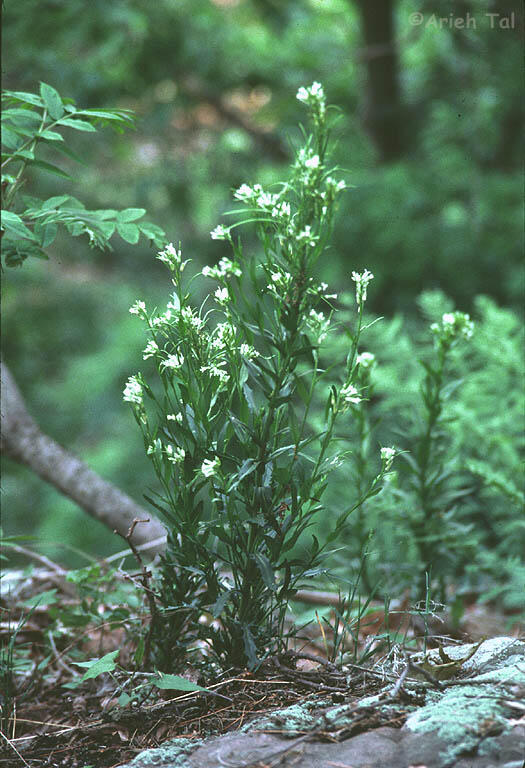
Green rock-cress flowering, image by Ariel Tal.
Green rock-cress (Borodinia missouriensis) is a tap-rooted biennial herb of sub-acid ledges and rocky woods. It is a member of the mustard family (Brassicaceae). It is a facultative biennial, persisting for a year or more as basal rosettes.
It is best to observe green rock-cress in both flower and fruit to confirm the identification. It is a glabrous (hairless) plant, growing 20–50 cm (8-20 in) in height. It has an average of 25 clasping stem leaves to the first flower. These stalkless leaves are up to 8 cm (3 in) in length and are somewhat overlapping. The basal leaves are arranged in a rosette and are up to 9 cm (3.5 in) long, and 1.5 cm (0.6 in) wide, and are irregularly dentate to pinnately lobed. The stem leaves may be slightly toothed to entire. The terminal inflorescence is a raceme consisting of 15 to 50 flowers. The flowers appear in May and early June and are creamy white with four petals (6-8 mm; 0.25 in) that are twice as long as the sepals. The fruits are siliques which are long (6–9 cm; 2.5–3.5 in) and very narrow (1-2 mm; <0.1 in). They first grow erect, but later in the season arch outwards, with the tip pointing down. The seeds have a conspicuously scalloped wing and are arranged in one row. Each is 1.7 mm (0.07 in) long by 1.2 mm (0.05 inch) wide. The siliques are present from late June through August. The smooth stems can be either bright green or reddish.
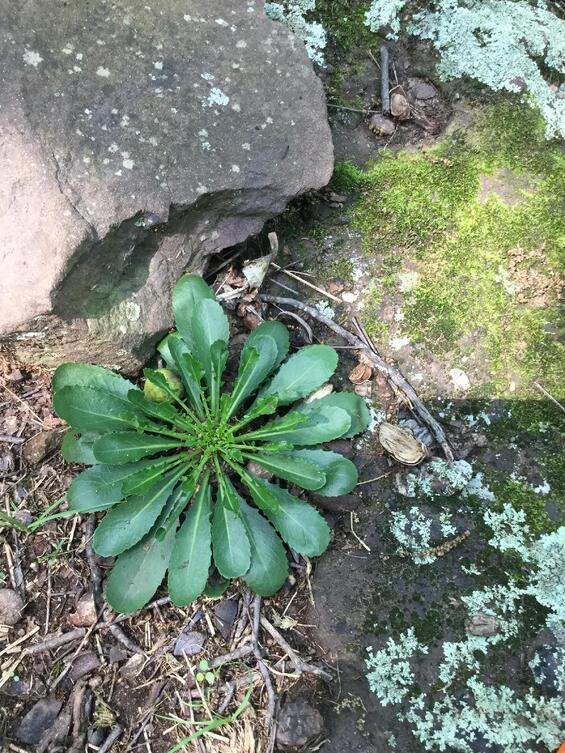
Basal rosette, image by Karro Frost.
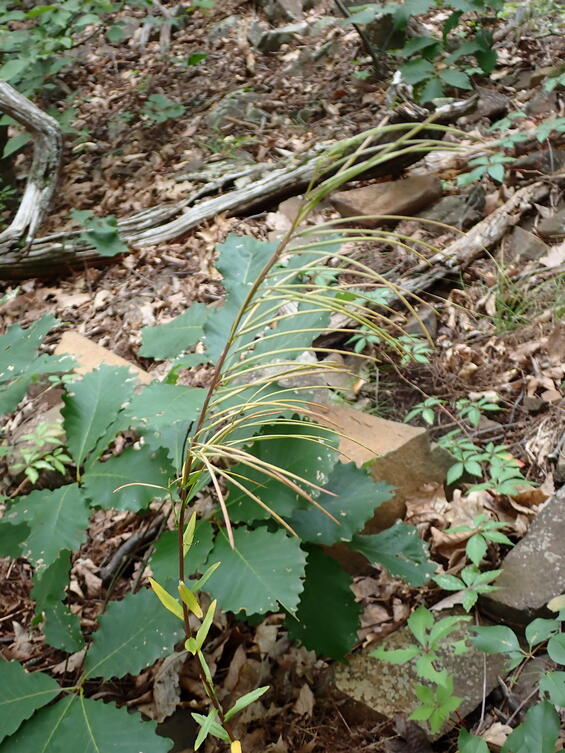
In fruit, image by Chris Buelow.
Life cycle and behavior
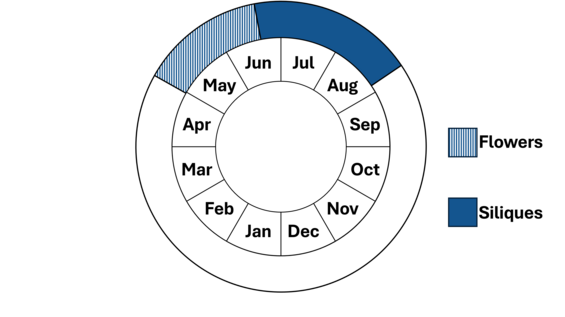
Green rock-cress typically produces leaves in a basal rosette during its first year and will produce a flowering stem in the second or third year, depending on growing conditions. The flowering stem typically grows in May, with mature fruits formed by mid to late June into July. Once the plant has flowered and produces seed, it dies. It is not known what pollinators visit this species, but a variety of generalist insect pollinators visit related species. Both long- and short-tongued bees visit the flowers for nectar and pollen. This species might also rely on self-pollination. The seeds are thought to be initially dormant and require a period of low temperatures to germinate, which may occur before or after the seeds fall from the parent plants. Most of the seeds fall at the base of the parent plants, but some are thought to remain in siliques until high winds from winter storms tug them free and spread them to new locations.
Population status
Green rock-cress is listed under the Massachusetts Endangered Species Act as Threatened. All listed species are legally protected from killing, collection, possession, or sale, and from activities that would destroy habitat and thus directly or indirectly cause mortality or disrupt critical behaviors. There are 30 populations which have been observed within the last 25 years occurring in Bristol, Franklin, Hampden, Hampshire, Middlesex, and Worcester counties. An additional 17 populations have been reported (or recorded in herbarium records) but have not been relocated.
Distribution and abundance
Green rock-cress was previously included as a variety of smooth rock-cress, with the species recognition by various organizations and authorities occurring from 1900 to 1990s. This may have led to a scattered delineation of populations between the two species. According to NatureServe (2025), green rock-cress occurs discontinuously across the eastern US and is considered rare in most states where it occurs. It is imperiled in Massachusetts, New Hampshire, New York, Georgia, Michigan, Ohio, and Wisconsin. It is critically imperiled in Maine, Vermont, Indiana, Iowa, Kansas, Maryland, New Jersey, Pennsylvania, North Carolina, and South Carolina. It is thought to be extirpated from Kentucky and is considered secure only in Missouri. It has not been assessed in Connecticut and 3 other states.
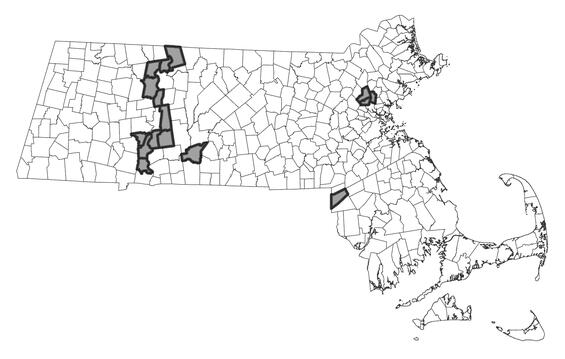
Distribution in Massachusetts
1999-2024
Based on records in the Natural Heritage Database
Habitat
Green rock-cress inhabits non-acidic ledges in rocky woods and hills with full to filtered light exposure, on mesic to dry soil. Associated vegetation may include red oak (Quercus rubra), hop hornbeam (Ostrya virginiana), pignut hickory (Carya glabra), sugar maple (Acer saccharum), wild columbine (Aquilegia canadensis), polypody fern (Polypodium virginianum), pale corydalis (Capnoides sempervirens), and pussytoes (Antennaria spp.). Pollinators have not been specifically studied in this species, but in related species, both short- and long-tongued bees visit flowers for both nectar and pollen. Self-pollination may be possible for this species, as it occurs in related plants.
Healthy habitats are vital for supporting native wildlife and plants. Explore habitats and learn about conservation and restoration in Massachusetts.
Image by Karro Frost
Threats
Green rock-cress may be over-shaded when habitat sites succeed to closed-canopy forest due to an absence of natural or anthropogenic disturbance, such as fire, cutting, mowing, or grazing. Invasive exotic shrubs and vines may over-shade or out-compete green rock-cress at some sites. Other threats include habitat loss due to development or resource extraction, and direct damage from off-road vehicles, trampling, or rock-climbing.
There have been no studies specifically assessing green rock-cress and its response to climate changes. Some related species appear to have plasticity to changes, while others seem to be extremely vulnerable (Allen 2019 as reported in Dodds 2023). The lack of information is an impediment to assessing its vulnerability to climate change.
Conservation
Survey and monitoring
Surveys for rare plants are always needed, and MassWildlife’s Natural Heritage & Endangered Species Program (NHESP) appreciates all rare species observations to be submitted. The plants are best surveyed when flowers and pods are both available, but it is identifiable with flowers May into June and with fruits from mid-June through August. Each basal rosette, or flowering stem, is a separate plant. Please note whether you are reporting plants that only have basal rosettes and ones that are in flower or fruit.
Management
As with many rare species, the exact management needs of green rock-cress are not known. Sites should be monitored for over-shading caused by forest succession, and for invasive plant species. Habitat sites that do not receive enough light can be managed with canopy thinning or prescribed burning. To avoid inadvertent harm to rare plants, all active management of rare plant populations (including invasive species removal) should be planned in consultation with the MassWildlife’s Natural Heritage & Endangered Species Program.
Research needs
Green rock-cress was only recognized as a separate species from smooth rock-cress (Borodinia laevigata) during the 1900s. As such, there is still much that is not understood, including its fragmented distribution. In addition, its pollination strategies and pollinators remain largely unknown. It is not known whether it can self-pollinate or not. Weakley et al. (2022) describe green rock-cress’ scattered range-wide distribution as “odd”. It is not known how seeds are dispersed over long distances or its establishment requirements.
References
Alexander, Patrick J., Michael D. Windham, James B. Beck, Ihsan A. Al-Shehbaz, Loreen Allphin, and C. Donovan Bailey. 2013. Molecular phylogenetics and taxonomy of the genus Boechera and related genera (Brassicaceae: Boechereae). Systematic Botany 38(1): 192–209.
Allen, Garrett. 2019. Exploring the Potential for Rare and Common Borodinia Species to Acclimate to Change. Honors Thesis, University of Tennessee, Chattanooga, TN 23 pp. As reported in Dodds, 2023.
Dodds, Jill S. 2023. Arabis missouriensis Rare Plant Profile. New Jersey Department of Environmental Protection, State Parks, Forests & Historic Sites, State Forest Fire Service & Forestry, Office of Natural Lands Management, New Jersey Natural Heritage Program, Trenton, NJ. 14 pp. (Accessed December 26, 2024) https://www.nj.gov/dep/parksandforests/natural/heritage/docs/arabis-missouriensis-missouri-rock-cress.pdf
Gleason, Henry A. and Arthur Cronquist.1991. Manual of Vascular Plants of Northeastern United States and adjacent Canada. NYBG. Bronx, NY
POWO (2024). "Plants of the World Online. Facilitated by the Royal Botanic Gardens, Kew. Published on the Internet; https://powo.science.kew.org/ Accessed 26 December 2024."
Seymour, F. C. 1969. The Flora of New England. Charles E. Tuttle Co., Rutland, Vermont.
Weakley, A.S. 2020. Flora of the southeastern United States. University of North Carolina Herbarium, North Carolina Botanical Garden, Chapel Hill, NC
Contact
| Date published: | March 25, 2025 |
|---|